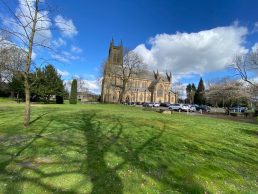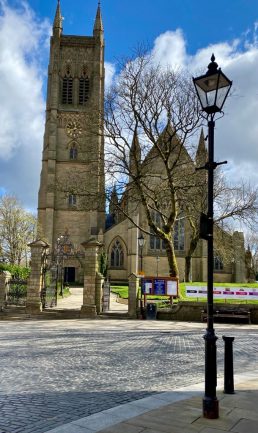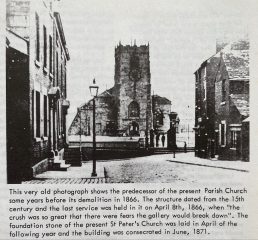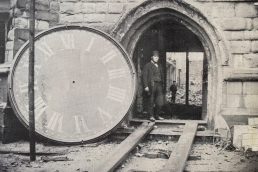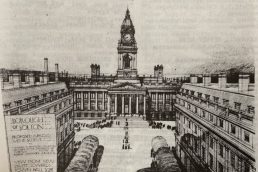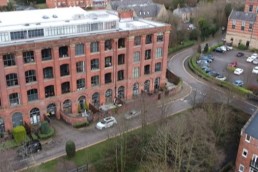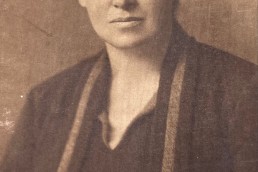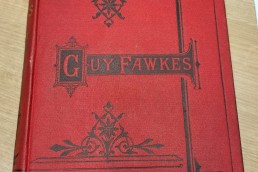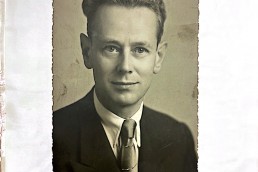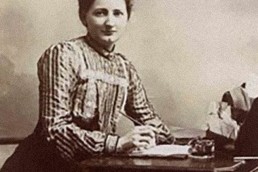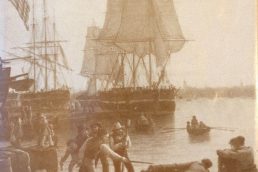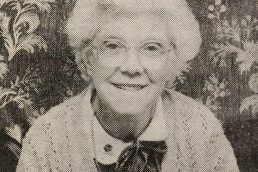Standing tall and majestic at the head of historic Churchgate stands Bolton Parish Church.
The tower, standing at the height of one hundred and eighty feet is purposely built to be the highest of all Parish Churches within Lancashire, and along with the grandiose Town Hall, it is symbolic of the newfound industrial wealth and confidence that the local council associated with the Victorian town. It represents a courageous show of belief and desire to put Bolton on the map, to align Bolton with larger cities.
This blog post shows a debt of gratitude to the work of Gordon Readyhough and W.E Brown whose photographic resources are republished here, and follows the Victorian Bolton article, ‘The Danes in Bolton: St Peter’s Parish Church, Bolton’, by Grace Soro.
The Parish Church is the fourth such church to stand on the site. The foundation stone was laid in April 1867 with the completed building officially consecrated four years later in June 1871. The tower of the church is positioned unusually on the Northwest corner of the building, intentionally showing the building in the most conspicuous way from Deansgate. The four turrets which surmount the tower are light-heartedly named after the first born of church officials from the time of consecration. Thus, one is called Harriet, another William. The third Cissie, with the final turret named Percy.
The predecessor of the current Church was erected during the fifteenth century and modified to suit the growing population during the eighteenth century with additional galleries added. This modification proved to be all but short lived.
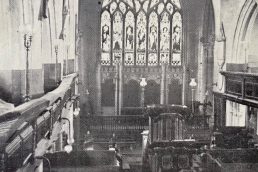

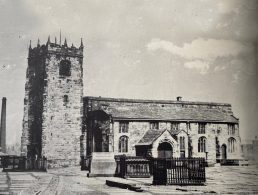

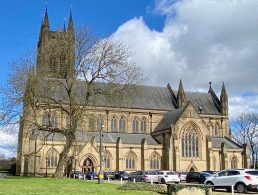

The last service being held on April 8th, 1866, it was feared that the overcrowding from the populace would be so great that it had the potential to cause significant injury or death. As Gordon Readyhough states in Bolton Town Centre: A Modern History ‘the crush was so great there were fears the gallery would break down’ (Readyhough, 1982, P35).
The tombs in the graveyard were duly flattened and tramlines laid to take away the stone from the demolition site. Notably the tomb of Samuel Crompton is prominent within the photograph.
Depicted during demolition in 1868, the Works Foreman stands in the west doorway of the Tower alongside one of the removed clock faces. Closer inspection reveals the interior of the church to be completely gutted at this stage.
The Parish Church now stands serenely settled within its own grounds, peacefully staring into the heart of Bolton via Churchgate and Deansgate. This, however, could have been quite different. Under plans drawn up during 1911 by Lord Leverhulme, embellished and emboldened by Thomas H Mawson (who had successfully worked with Leverhulme on his Rivington Estate), it was suggested that the Parish Church would stand at one end of a tree-lined avenue that linked Town Hall to Church (Salveson cited by Anson, 2020). Indeed, Mawson put forward his vision of a brave new Bolton to the town council during 1916 (Salveson cited by Anson, 2020).
These lectures were published by the Tillitsons in 1916 under the auspices of Bolton as It Is, and As It Might Be.
Bolton based Historian and writer, Professor Paul Salveson, visiting professor in Worktown Studies at the University of Bolton and as cited by Anson in The Bolton News stated that
‘Mawson had a strong kinship with Bolton, in part through his friendship with WH Lever [Leverhulme] but also through links to the Bolton Housing and Town Planning Society, a ‘civic’ organisation which included Dr John Johnston, a local GP and member of the Walt Whitman fellowship which had a subtle but important influence on early English socialism, which was far removed from the later focus on state ownership and centralisation’
(Salveson qtd. by Anson, 2020).
Bolton Council adopted a plan of their own which did not have the same bravery as the Leverhulme / Mawson plans. The wide tree-lined avenue was never built. His son, the second Viscount Leverhulme, opined that
‘whether the citizens of Bolton a century hence will endorse the considered opinion of their predecessors, or sigh for Leverhulme’s grander scheme time alone will show’
(Leverhulme, 1927, P103).
Bolton Parish Church has an excellent online presence which outlines the services and events being held there; the link to this is here.
Bibliography
Anson, J., (2020) Visionary who sought to transform Bolton and make the town beautiful. [online] The Bolton News. Available at: <https://www.theboltonnews.co.uk/news/18652646.visionary-town-planner-sought-make-bolton-beautiful/> [Accessed 2 April 2022].
Brown, W., (1972) Bolton As It Was. Nelson: Hendon.
Bolton As it is And As it Might Be. (1917) Landscape Architecture, 7(4), p. 204. [Online] Available at: <http://www.jstor.org/stable/44659502> [Accessed 2 April 2022].
Lever, W., (1927) Viscount Leverhulme. London: Methuen.
Mawson, T., 1917. Bolton as it is and as it might be. Bolton: Tillotson.
Readyhough, G., 1982. Bolton Town Centre: A Modern History. Manchester: Richardson.

